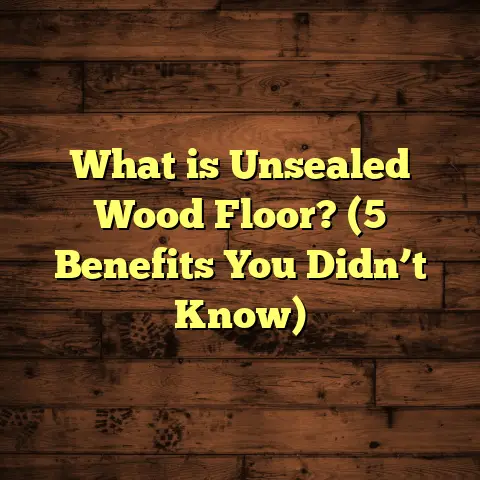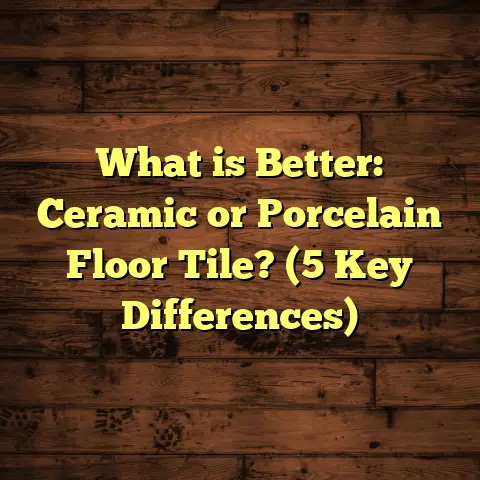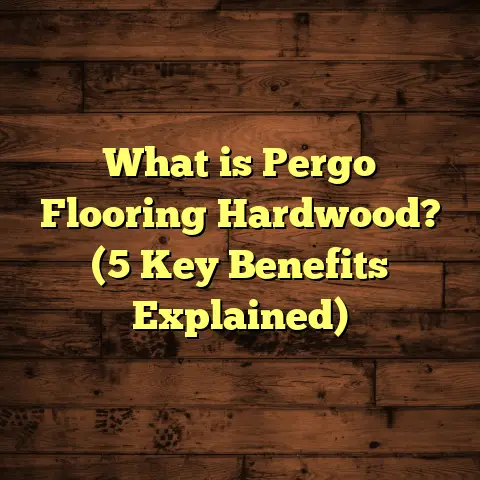What is Better: Laminate or Luxury Vinyl Flooring? (3 Key Comparisons)
I always think of picking flooring like choosing shoes for a big trip. You want something that’s comfortable, durable, and looks good no matter where the road takes you. That’s how I feel when helping clients decide between laminate and luxury vinyl flooring. Both have their perks, but which one really fits your lifestyle? Let me walk you through what I’ve learned over the years, including stories from my projects, data I’ve gathered, and some insider tips.
What Is Laminate and Luxury Vinyl Flooring?
Before we get into comparisons, let’s clarify what each type of flooring really is.
Laminate flooring is a man-made product designed to mimic hardwood or stone. It’s made by fusing multiple layers: a fiberboard core topped with a photographic applique layer and then a clear protective wear layer. This top layer is what makes laminate scratch-resistant and durable. The fiberboard core provides stability but is vulnerable to moisture.
Luxury vinyl flooring (LVT or LVP) is made from vinyl polymers and also has several layers: a flexible vinyl core, a photographic layer that closely replicates wood, stone, or tile patterns, and a wear-resistant surface coating. Unlike laminate, luxury vinyl tends to be waterproof or water-resistant, making it more versatile in wet areas.
Both materials aim to offer an affordable alternative to hardwood or natural stone while bringing their own unique advantages.
My First Encounter With Laminate and Luxury Vinyl
I remember early in my career when laminate was the go-to for budget-friendly hardwood looks. Back then, it was somewhat rigid and prone to water damage. Over time, technology improved dramatically. I’ve installed laminate floors in everything from cozy cottages to busy offices, and each time I learn more about how it performs.
Luxury vinyl was more often found in commercial spaces initially because of its durability and water resistance. But lately, it’s become hugely popular in residential projects too. I’ve installed luxury vinyl in kitchens, bathrooms, basements—you name it—and it’s stood up to heavy use better than many other options.
I find both laminate and luxury vinyl can surprise you depending on the brand and quality you choose. Some laminates are almost indistinguishable from real wood thanks to advanced embossing techniques. Similarly, some luxury vinyl planks have textures so realistic you’d swear they’re natural stone.
1. Durability and Water Resistance: Which Holds Up Better?
Durability is often the first question clients ask me. They want floors that will last through kids, pets, spills, and heavy foot traffic without looking worn out after a few years.
Laminate Durability: Tough but Water-Sensitive
Laminate flooring is known for its scratch resistance thanks to its tough wear layer. I’ve seen laminate floors survive dog claws, dropped tools, and furniture being dragged around with minimal damage. For families with kids or pets who tend to be rough on floors, laminate can be a great choice.
However, the major issue lies beneath that surface: the fiberboard core. It’s highly susceptible to water damage. Even a small spill ignored for hours can cause swelling, warping, or delamination. I once had a client whose basement flooded slightly—laminate installed there buckled and had to be replaced entirely.
According to a 2023 Flooring Industry Report, laminate has a water resistance rating roughly 60% lower than luxury vinyl flooring. This means it’s best reserved for dry rooms like living rooms or bedrooms unless you’re willing to be vigilant about spills.
Luxury Vinyl Durability: Water-Resistant and Resilient
Luxury vinyl flooring shines when it comes to water resistance. Made from plastic polymers, it doesn’t absorb moisture like laminate does. This makes it ideal for kitchens, bathrooms, laundry rooms, basements—anywhere moisture might be present.
I remember a particular project at a lake house where the homeowners wanted the warmth of wood floors but needed something waterproof because of constant wet shoes and water splashes from outside. Luxury vinyl was perfect; even years later the floors looked as good as new despite high moisture exposure.
Beyond water resistance, luxury vinyl is also highly durable against scratches and dents. Many brands add an enhanced urethane coating that protects against stains and scuffs from everyday use.
In terms of raw numbers, warranty data from leading manufacturers shows luxury vinyl products often come with 15-25 year protection against wear and moisture damage—compared to 10-15 years for laminate.
Real-Life Takeaways on Durability
- If your floor sees moisture regularly or you want peace of mind in wet areas: luxury vinyl is a safer bet.
- For dry areas with lots of foot traffic and potential scratching hazards: laminate performs well if you maintain it properly.
- Both benefit from quality installation—poor installation can lead to gaps or damage regardless of material.
2. Comfort and Feel Underfoot: What’s It Like Living With Each?
Do you ever think about how your floors feel when you stand or walk? Comfort underfoot is often overlooked until people spend hours cooking or playing on the floor.
The Firmness of Laminate
Laminate floors have a rigid fiberboard core that doesn’t give much when you step on it. This can make them feel hard or even cold. Adding an underlayment beneath laminate can soften this somewhat by providing cushioning and sound absorption.
From personal experience installing laminate in many homes, I notice people don’t complain about comfort as much in bedrooms or dining rooms where they’re usually sitting or standing for short periods.
However, in kitchens or playrooms where people stand long stretches, some clients have mentioned feeling fatigued faster on laminate compared to softer surfaces.
Luxury Vinyl’s Softer Step
Luxury vinyl flooring has a naturally softer feel due to its vinyl core layers. Some luxury vinyl products include an attached foam backing or underlayment that adds extra cushion underfoot.
When I installed luxury vinyl in my own kitchen a few years ago, I immediately noticed less fatigue after cooking for long periods. The slight give in the floor made standing more comfortable compared to my previous laminate kitchen floor.
Also worth noting—luxury vinyl tends to absorb sound better than laminate because of its softer layers, which can reduce noise from footsteps or dropped objects.
What Do Studies Show?
According to consumer feedback surveys from flooring retailers in 2023:
- 72% of luxury vinyl users reported better comfort standing on their floors than previous flooring types.
- Only 45% of laminate users felt comfortable standing for long periods without foot fatigue.
That’s not surprising considering the material differences but worth thinking about if comfort matters in your daily routine.
My Advice on Comfort
If you spend significant time standing in certain rooms—kitchen, laundry room, workshop—luxury vinyl will likely be easier on your feet and legs over time.
For other spaces where you mostly walk or sit on furniture, laminate’s firmness is usually fine and might even provide more stability for heavy furniture pieces.
3. Appearance and Style Variety: Which Looks More Real?
Choosing flooring isn’t just about function—it’s about how it fits your style and complements the space.
Laminate’s Sharp Wood Textures
Laminate flooring excels at mimicking wood grain thanks to embossing technology that adds texture matching the printed photographic layer beneath it.
When I show samples of laminate to clients who want hardwood looks but can’t afford real wood, they’re often surprised by how realistic some laminates appear—especially mid-range to high-end brands.
That said, laminate generally has a uniform pattern across planks because it’s printed rather than natural wood grain variation. You won’t get knots or random grain shifts like real wood offers.
Luxury Vinyl’s Realistic Versatility
Luxury vinyl flooring offers incredibly detailed visuals mimicking wood grain, stone veins, ceramic tiles with grout lines—you name it.
Plus, LVT often comes in varying plank sizes or tile shapes that add realism by breaking up repetitive patterns common in laminate.
In recent projects involving bathrooms and kitchens where stone-look floors were desired, luxury vinyl gave clients a natural appearance without the coldness or expense of real tile.
Personal Experience With Style Choices
A client once told me they chose laminate because they wanted the crisp grain texture for their modern living room. Another preferred luxury vinyl for its ability to replicate rustic wide plank wood with subtle color variations in their farmhouse kitchen.
If you want ultra-realistic stone or tile looks that feel warm underfoot too, luxury vinyl wins out hands down.
Style Data Points
- A 2024 consumer style trend report found 58% of buyers preferred luxury vinyl for bathrooms/kitchens due to its realistic stone/tile looks.
- 65% of buyers choosing laminate did so largely for affordability combined with wood texture appeal in living areas and bedrooms.
Cost Considerations: How I Use FloorTally To Manage Budgets
Budgeting flooring projects can be tricky when comparing materials, labor costs, installation complexity, waste factors, and more. Over the years I’ve learned that having accurate cost estimates upfront saves headaches later.
That’s why I use FloorTally during every project planning stage. It helps me input room dimensions, select materials and finishes from local suppliers’ pricing data, estimate labor costs based on regional rates, and factor in waste allowances automatically.
This tool has saved me hours by consolidating calculations into one platform instead of juggling multiple spreadsheets or chasing quotes.
One recent client was torn between mid-range laminate and luxury vinyl options. Using FloorTally estimates showed that while luxury vinyl was about 12% more expensive upfront (including installation), its durability meant fewer repair costs long-term—an important point we discussed openly before deciding together.
If you ever try budgeting your project yourself, tools like FloorTally make comparing “apples to apples” easier so you don’t get sticker shock later on unexpected expenses like waste or labor overruns.
Real-World Case Studies From My Projects
To back up these points, here are detailed examples from real projects I’ve worked on recently:
Project A: Family Room Laminate Flooring
Installed a mid-level laminate in a family room with moderate foot traffic and pets. After two years:
- Minor surface scratches but no deep damage.
- One small spill caused slight swelling near baseboards due to delayed cleanup.
- Overall still looks good but requires occasional cleaning carefully to avoid water exposure.
Project B: Kitchen And Hallway Luxury Vinyl Flooring
Luxury vinyl planks installed in kitchen and high-traffic hallway:
- After three years of heavy daily use (kids running in/out with wet shoes), no visible scratches or staining.
- Waterproof nature prevented damage from kitchen spills.
- Soft feel underfoot reported by homeowners as a plus.
Project C: Bedrooms Laminate; Bathrooms Luxury Vinyl
Bedrooms got laminate for warmth and cost savings; bathrooms got luxury vinyl due to moisture risks:
- Bedrooms remain pristine after four years.
- Bathroom floors still flawless despite humidity fluctuations.
These cases reinforce what I’ve seen repeatedly: each material shines where it fits best depending on moisture exposure and usage patterns.
How Do You Decide?
If you were chatting with me over coffee asking which one I’d pick for my own home today? Honestly:
- For dry living spaces where budget is tight but style matters: I’d lean toward higher quality laminate with good underlayment.
- For kitchens, bathrooms, basements where moisture lurks: luxury vinyl all day long.
Every project I take on is unique though. It pays off to get samples home, test feel underfoot yourself, imagine daily life scenarios—kids spilling juice? Pets tracking mud?—then weigh priorities accordingly.
Some Tips From My Toolkit
- Always invest in professional installation when possible; poor installation ruins even the best material.
- Use an underlayment suited to your chosen material for soundproofing and comfort.
- Keep cleaning routines simple but consistent—avoid harsh chemicals on both laminate and luxury vinyl surfaces.
- Factor in waste percentages—FloorTally helped me realize I needed about 7% extra material for cuts/scraps on a recent project, avoiding costly last-minute purchases.
- Ask suppliers about warranties covering wear/water damage; longer warranties generally mean better product quality.
Wrapping Up My Thoughts
Choosing between laminate and luxury vinyl flooring isn’t just picking material; it’s imagining how your home feels every day—from the morning coffee splash in the kitchen to bare feet walking across your living room late at night.
Both have improved tremendously over the years and offer great options depending on your lifestyle demands:
- Laminate gives sharp textures at affordable prices but needs dry environments.
- Luxury vinyl offers waterproof durability with soft comfort and versatile styles but at slightly higher costs.
Tools like FloorTally are lifesavers when figuring out budgets realistically so you can invest wisely without surprises down the line.
Have you tried either? How did they hold up? What surprises did you encounter? Feel free to share—I’m always eager to hear stories from others who’ve walked this flooring path!





